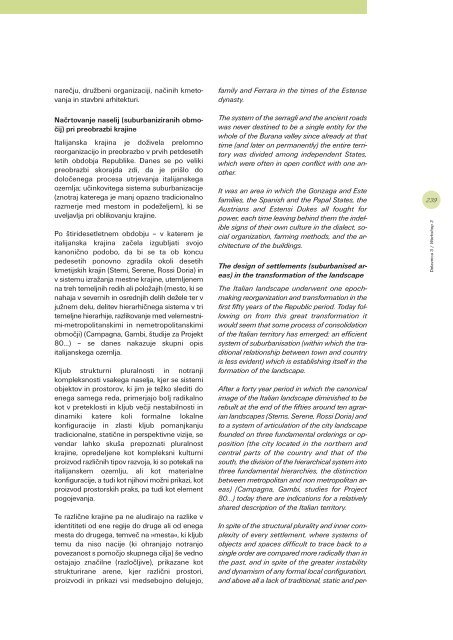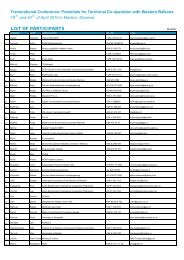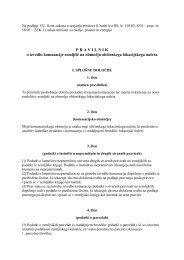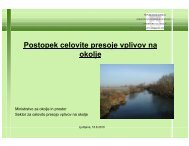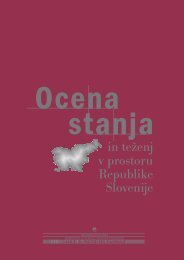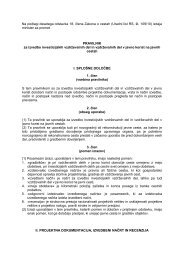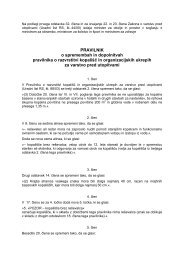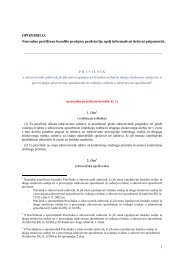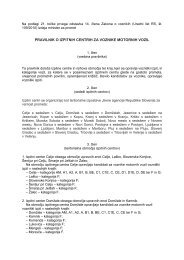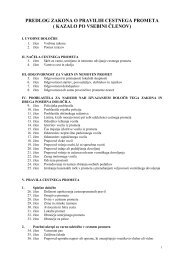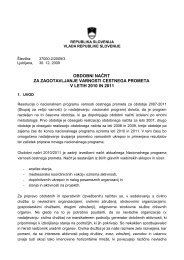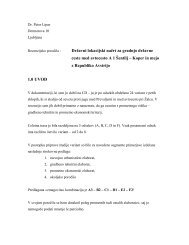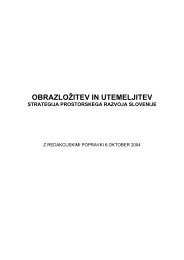evropska konvencija o krajini - Ministrstvo za infrastrukturo in prostor
evropska konvencija o krajini - Ministrstvo za infrastrukturo in prostor
evropska konvencija o krajini - Ministrstvo za infrastrukturo in prostor
Create successful ePaper yourself
Turn your PDF publications into a flip-book with our unique Google optimized e-Paper software.
narečju, družbeni organi<strong>za</strong>ciji, nač<strong>in</strong>ih kmetovanja<strong>in</strong> stavbni arhitekturi.Načrtovanje naselij (suburbaniziranih območij)pri preobrazbi kraj<strong>in</strong>eItalijanska kraj<strong>in</strong>a je doživela prelomnoreorgani<strong>za</strong>cijo <strong>in</strong> preobrazbo v prvih petdesetihletih obdobja Republike. Danes se po velikipreobrazbi skorajda zdi, da je prišlo dodoločenega procesa utrjevanja italijanskegaozemlja; uč<strong>in</strong>kovitega sistema suburbani<strong>za</strong>cije(znotraj katerega je manj opazno tradicionalnorazmerje med mestom <strong>in</strong> podeželjem), ki seuveljavlja pri oblikovanju kraj<strong>in</strong>e.Po štiridesetletnem obdobju – v katerem jeitalijanska kraj<strong>in</strong>a <strong>za</strong>čela izgubljati svojokanonično podobo, da bi se ta ob koncupedesetih ponovno zgradila okoli desetihkmetijskih kraj<strong>in</strong> (Stemi, Serene, Rossi Doria) <strong>in</strong>v sistemu izražanja mestne kraj<strong>in</strong>e, utemljenemna treh temeljnih redih ali položajih (mesto, ki senahaja v severnih <strong>in</strong> osrednjih delih dežele ter vjužnem delu, delitev hierarhičnega sistema v tritemeljne hierarhije, razlikovanje med velemestnimi-metropolitanskimi<strong>in</strong> nemetropolitanskimiobmočji) (Campagna, Gambi, študije <strong>za</strong> Projekt80...) – se danes nakazuje skupni opisitalijanskega ozemlja.Kljub strukturni pluralnosti <strong>in</strong> notranjikompleksnosti vsakega naselja, kjer se sistemiobjektov <strong>in</strong> <strong>prostor</strong>ov, ki jim je težko slediti doenega samega reda, primerjajo bolj radikalnokot v preteklosti <strong>in</strong> kljub večji nestabilnosti <strong>in</strong>d<strong>in</strong>amiki katere koli formalne lokalnekonfiguracije <strong>in</strong> zlasti kljub pomanjkanjutradicionalne, statične <strong>in</strong> perspektivne vizije, sevendar lahko skuša prepoznati pluralnostkraj<strong>in</strong>e, opredeljene kot kompleksni kulturniproizvod različnih tipov razvoja, ki so potekali naitalijanskem ozemlju, ali kot materialnekonfiguracije, a tudi kot njihovi možni prikazi, kotproizvod <strong>prostor</strong>skih praks, pa tudi kot elementpogojevanja.Te različne kraj<strong>in</strong>e pa ne aludirajo na razlike videntititeti od ene regije do druge ali od enegamesta do drugega, temveč na »mesta«, ki kljubtemu da niso nacije (ki ohranjajo notranjopove<strong>za</strong>nost s pomočjo skupnega cilja) še vednoostajajo značilne (razločljive), prika<strong>za</strong>ne kotstrukturirane arene, kjer različni <strong>prostor</strong>i,proizvodi <strong>in</strong> prikazi vsi medsebojno delujejo,family and Ferrara <strong>in</strong> the times of the Estensedynasty.The system of the serragli and the ancient roadswas never dest<strong>in</strong>ed to be a s<strong>in</strong>gle entity for thewhole of the Burana valley s<strong>in</strong>ce already at thattime (and later on permanently) the entire territorywas divided among <strong>in</strong>dependent States,which were often <strong>in</strong> open conflict with one another.It was an area <strong>in</strong> which the Gon<strong>za</strong>ga and Estefamilies, the Spanish and the Papal States, theAustrians and Estensi Dukes all fought forpower, each time leav<strong>in</strong>g beh<strong>in</strong>d them the <strong>in</strong>deliblesigns of their own culture <strong>in</strong> the dialect, socialorgani<strong>za</strong>tion, farm<strong>in</strong>g methods, and the architectureof the build<strong>in</strong>gs.The design of settlements (suburbanised areas)<strong>in</strong> the transformation of the landscapeThe Italian landscape underwent one epochmak<strong>in</strong>greorgani<strong>za</strong>tion and transformation <strong>in</strong> thefirst fifty years of the Republic period. Today follow<strong>in</strong>gon from this great transformation itwould seem that some process of consolidationof the Italian territory has emerged; an efficientsystem of suburbanisation (with<strong>in</strong> which the traditionalrelationship between town and countryis less evident) which is establish<strong>in</strong>g itself <strong>in</strong> theformation of the landscape.After a forty year period <strong>in</strong> which the canonicalimage of the Italian landscape dim<strong>in</strong>ished to berebuilt at the end of the fifties around ten agrarianlandscapes (Stems, Serene, Rossi Doria) andto a system of articulation of the city landscapefounded on three fundamental order<strong>in</strong>gs or opposition(the city located <strong>in</strong> the northern andcentral parts of the country and that of thesouth, the division of the hierarchical system <strong>in</strong>tothree fundamental hierarchies, the dist<strong>in</strong>ctionbetween metropolitan and non metropolitan areas)(Campagna, Gambi, studies for Project80…) today there are <strong>in</strong>dications for a relativelyshared description of the Italian territory.In spite of the structural plurality and <strong>in</strong>ner complexityof every settlement, where systems ofobjects and spaces difficult to trace back to as<strong>in</strong>gle order are compared more radically than <strong>in</strong>the past, and <strong>in</strong> spite of the greater <strong>in</strong>stabilityand dynamism of any formal local configuration,and above all a lack of traditional, static and per-239Delavnica 3 / Workshop 3


